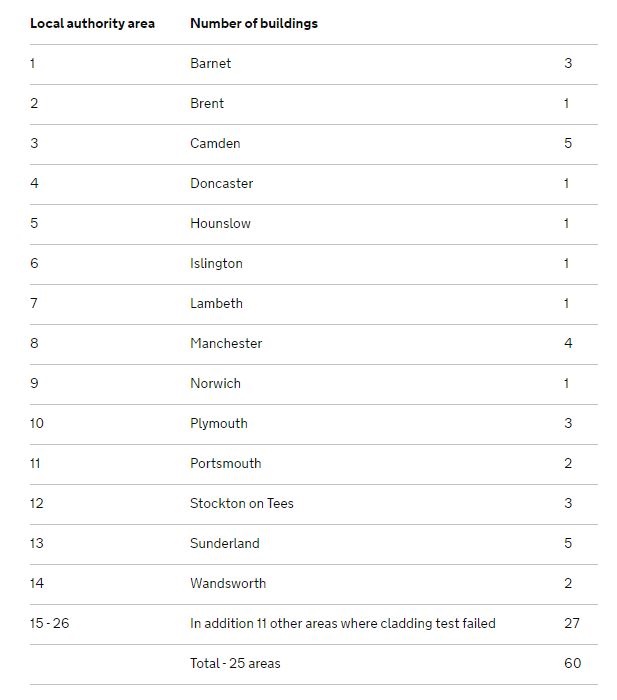26.06.17
Managing fire safety ‘broken’ as tower blocks in 25 areas fail combustibility tests
The government has this week revealed that 60 buildings with cladding similar to Grenfell Tower across 25 local authority areas have failed combustibility tests. These include a number of areas in London, such as Barnet, Islington and Brent as well as Doncaster, four buildings in Manchester and five in Sunderland.
In one area, Camden, where five buildings were found to be unsafe, residents were evacuated from a building on Chalcots Estate and put into hotels by the authority to allow for essential fire safety work to be carried out.

Above: the full list of buildings that failed a combustibility test
And now, a number of organisations including the Local Government Association (LGA) and the National Fire Protection Association (NFPA) have offered advice to authorities on how to safeguard buildings and ease the minds of worried high-rise residents.
This comes after a number of authorities moved to fit sprinklers in high-rise buildings last Wednesday to protect residents in the case of a fire.
A spokesperson for the LGA said the organisation understood that this was an “unsettling time” for communities as many cladding samples were being confirmed as highly combustible. They also stated that councils were contacting residents living in tower blocks who had failed tests and are working with fire services to figure out what action needs to be taken in the future.
“Councils are also supporting social and other landlords in their area to help them in their work to ensure the safety of their residents when cladding on their buildings fail tests,” the spokesperson added.
“Where cladding fails the test, this will not necessarily mean moving residents from tower blocks,” they continued. “In Camden, the decision to evacuate was based on fire inspectors’ concerns about a combination of other fire safety concerns together with the cladding.”
The LGA went on to explain that a number of councils had already introduced additional fire safety measures in buildings, like 24-hour a day warden patrols when advice from the fire service is clear that this will mitigate against fire risks ahead of the removal of cladding.
“For those areas still waiting for results of tests on aluminium composite material (ACM) cladding, our advice to them is to prepare contingency plans so they can take any measures needed quickly,” the LGA spokesperson concluded. “Anyone living in a high-rise building can be reassured that their council will act on any advice from the fire service to ensure their safety.”
System for managing fire safety is ‘broken’
A blog post by James Pauley, president and CEO of the NFPA, said that outdated fire safety codes and standards and the acceptance of reduced safety requirements to save money were blamed as other factors in the national decline of fire safety standards.
“When government and other entities don’t adopt or designers don’t use the latest versions of codes and standards, they lose the benefit of the latest technology, research and collective wisdom related to fire, electrical and life safety,” Pauley wrote.
“When policymakers decide to remove life safety and property protection provisions from codes, they have substituted politics for technical requirements that were determined after extensive input from across the spectrum of knowledgeable people.”
But Pauley also suggested that responsibility for fire safety was something that the public needed to be better educated on, as improper actions during fires was more likely to put people in a perilous situation.
“The system the public relies on for managing fire safety is broken and a single solution isn’t the answer,” Pauley concluded. “It will take a systems approach to fix it.
“We may not be able to prevent every tragedy from occurring, but by recommitting to and promoting a full system of fire prevention, protection and education, we can help save lives and reduce loss. That is the story that should consume the news of the day.”
Top Image: Ik Aldama, DPA, PA Images
Have you got a story to tell? Would you like to become a PSE columnist? If so, click here.